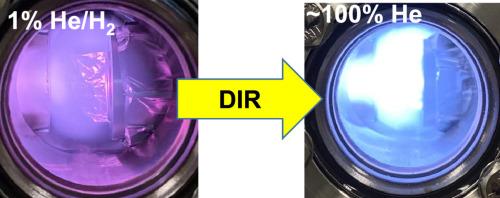Direct internal recycling fractions approaching unity
IF 1.9
3区 工程技术
Q1 NUCLEAR SCIENCE & TECHNOLOGY
引用次数: 0
Abstract
Direct internal recycling (DIR) refers to the process of recovering pure hydrogen isotopes (D/T) from helium and other impurities in the fusion plasma exhaust and directing them back to the fuel injection system. Increasing the exhaust fraction purified through DIR significantly reduces the size and cost of the tritium plant and provides additional benefits including reduced requirements for both the tritium startup inventory and tritium breeding ratio. Metal foil pumps (MFPs) are the dominant technology for this separation, relying on the concept of superpermeation. We recently demonstrated that PdCu foils operated at low temperature provide both exceptional flux and resilience to helium absorption as the DIR fraction is increased. Herein we design and demonstrate continuous and semi-batch DIR processes using PdCu MFPs. Under continuous processing, stable performance was observed for DIR fractions up to 92 %. In addition, we demonstrate a semi-batch process capable of extending the DIR fraction to unity (> 99.8 %). Under the experimental conditions described within a PdCu MFP area of ∼22 m2 would be sufficient to process the fusion exhaust with 92 % DIR fraction at expected flowrates of 100 Pa·m3·s−1 for a future fusion power plant.

直接内部再循环分数接近统一
直接内部循环(DIR)是指从聚变等离子体废气中的氦和其他杂质中回收纯氢同位素(D/T),并将其导回到燃料喷射系统的过程。通过 DIR 增加排气纯化部分可显著降低氚设备的尺寸和成本,并带来其他好处,包括减少对氚启动库存和氚繁殖率的要求。金属箔泵(MFP)是这种分离的主流技术,它依赖于超渗透概念。我们最近演示了在低温下运行的钯铜箔,随着 DIR 分数的增加,可提供卓越的通量和对氦吸收的弹性。在此,我们设计并演示了使用 PdCu MFP 的连续和半批量 DIR 工艺。在连续处理过程中,观察到 DIR 分数高达 92% 时性能稳定。此外,我们还演示了一种半批量工艺,该工艺能够将 DIR 分数提高到统一水平(99.8%)。在所述实验条件下,PdCu MFP 面积为 ∼22 m2,足以处理未来核聚变电厂在预期流量为 100 Pa-m3-s-1 时产生的含 92 % DIR 的核聚变废气。
本文章由计算机程序翻译,如有差异,请以英文原文为准。
求助全文
约1分钟内获得全文
求助全文
来源期刊

Fusion Engineering and Design
工程技术-核科学技术
CiteScore
3.50
自引率
23.50%
发文量
275
审稿时长
3.8 months
期刊介绍:
The journal accepts papers about experiments (both plasma and technology), theory, models, methods, and designs in areas relating to technology, engineering, and applied science aspects of magnetic and inertial fusion energy. Specific areas of interest include: MFE and IFE design studies for experiments and reactors; fusion nuclear technologies and materials, including blankets and shields; analysis of reactor plasmas; plasma heating, fuelling, and vacuum systems; drivers, targets, and special technologies for IFE, controls and diagnostics; fuel cycle analysis and tritium reprocessing and handling; operations and remote maintenance of reactors; safety, decommissioning, and waste management; economic and environmental analysis of components and systems.
 求助内容:
求助内容: 应助结果提醒方式:
应助结果提醒方式:


